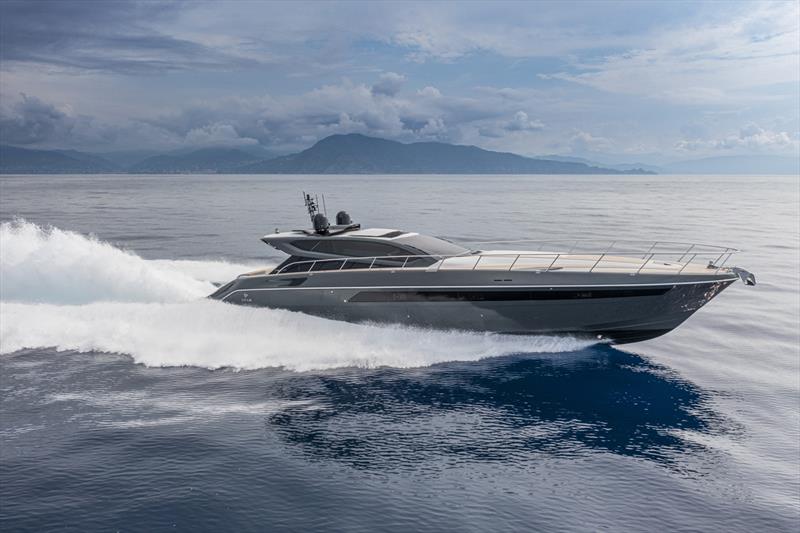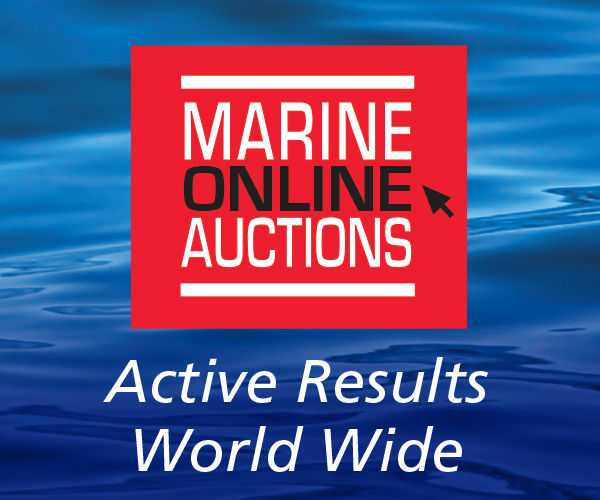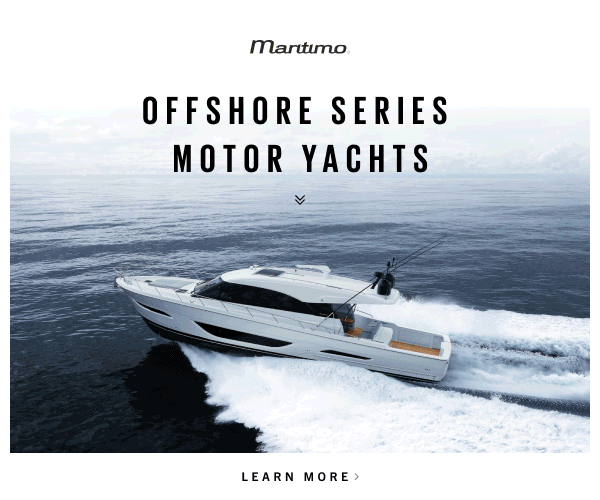
Otam 70ht unit #3 - photo © Alberto Cocchi
Dear Recipient Name
It's what my father used to say to my three other siblings and I whenever the energy got a little, shall we say, animated, and the volume went up to raucous, on its way to unbearable. So, at the risk of sounding like dad, I just want to say 'cool it' to everyone who seems to be on the alternative fuels bandwagon of late, which just so happens to be a behemoth of a thing. Way, way larger than any Ford Class CVN, ULCC, or the Oasis of the Seas, BTW...
We have said it before and will reiterate it now; nothing is as cheap as a litre of Diesel. No-one, and we mean no-one, has developed an extension lead long enough for boating, and there's always the old trip hazard problem to get around, which has also not been resolved to date. Equally, wireless charging has a bit of a proximity issue to rule it out immediately. Hydrogen and Ammonia will have a place, but presently that outcome looks best reserved for vessels of the sizes indicated above, or the occasional giga yacht.
| |

|
|

|
| |
Electric is great for lakes and what have you, but batteries are heavy, really heavy, and overall range to LOA will always be an issue. Solar is fine, and you are clearly no speed demon when pursuing this path, but most of all you have to take into account modern battery life, and then deal with the not-even-close-to-being-green hurdle that is what the hell to do with them when they are at the pearly gates. Not like you can just put them out to pasture to have a grand old time in the twilight years.
Also, it is important to remember which fuel source mined the stuff, sent it to processing, then off to a battery manufacturer, down to the builder, and ultimately off to you, the customer. Let alone what created the charge to put into them. Of course, do not even start on the fire side of things with certain types, and the dangers and outrageous toxicity thereof. Yikes.
So for now that leaves fossil Diesel, and the soon-to-be-more-widely-available HVO or Hydrotreated Vegetable Oil. e-Methanol may, and we mean may, come on board in ten years or more, and it will be sublime by virtue of its end-to-end carbon neutrality, but it has no real punch. It would be like a kindergarten child facing up to Rocky. You'll either have to go slower, have a smaller boat with the same size engine room, or go with bigger donks.
Yes, electric does deliver a smack over the gills, but you have to take into account the generation source, which is either fossil, or fission. At this stage we do not have the tech to make conversion from the biggest fusion reactor that ever was in these here parts for anything other than dawdling pace. Nice thing to ponder, and Solar Sailer from Tron: Legacy looks awesome and so forth, but we're right here, right now! Equally, last time I scouted around, Mr Fusion had not made his way down from the back of the DeLorean, and subsequently into every engine room on the planet.
Somewhat of an aside, but still fundamental to the whole deal here, SCR or Selective Catalytic Reduction does work for Tier III IMO (Tier IV EPA), but you are taking up more space in the engine room, and creating more backpressure to the system, so there are new pistons and maybe rods required.
Also, with the kinds of volumes of gasses big oil burners push through, you're going to need a lot of rare earth minerals to make the converters, and they are finite (hence the name), to say nothing of expensive to acquire and challenging/costly to mine. Much better to stick with Tier II IMO (Tier III R EPA) for as long as we can. Do not get brainwashed on some climate change fiasco.
Right. Next thing to cover off before people attack their keyboards is some relativity to the overall scenario here. We'll start with just the one stat. Based on the Global Carbon Atlas data from 2018, we (as in the royal 'we') account for a measly 4% of fossil fuel emissions. So that includes all shipping, ferries, coastal luggers, fishos; the lot! As too every freight train snaking its way across any continent, as well as us mere boaties. 4%!
Even air transport is only 2%, and don't the kerosene canaries just love to burn the stuff. Our residences and services are a not insignificant 9%. However, it gets serious by the time you're talking road transport at 18%, manufacturing, construction, mining, and industry at 24%, and then the mother lode with power generation at a mesmerising 42%. Is that not a glass of shut the &*^# up or what?!
To be clear, we're not talking about doing nothing. Just saying, "steady". Cool your jets.
HVO alone can get up to 80% less particulates being ejected overboard, as well an average of 8% lower harmful NOx joining the atmosphere. CO2 will be reduced by HVO's use alone, and might be in the order of 90%, it just depends on the farmer's overall position. So rather than lay claim to a fixed number, let's just say you're way in front, just for choosing HVO, and you do not lose anything from either the reach or power of your punch. Cue the Rocky theme song.
Of course, overall fuel efficiency has to be accounted for here. If you burn less, you emit less. In Not your average Iron Ladies we looked at three brands of 2000hp Diesels and saw that you can have up to 32% more consumption per hour, per side than the class leader. That's 60lph, which is a tankful in certain mid-size Diesel cars and that can get you up to 1000km down the road.
Outboards have grown in displacement and popularity in the most amazing ways. It is not that long ago that 200hp was a monster donk on the transom. Now we are at 600hp, and there are just about always multiples of them. A 7.6 litre engine still needs a lot of fuel, especially at full noise. 190lph each across four engines adds up swiftly. At a swift cruise pace it will still be 95lph, each.
They're also heavy (a 600hp motor is 572kg - read Full Stop = Full Bore for an interesting take on it all), they hang off the back, and transform the ride characteristics enormously.
Faster than some alternatives? In many cases (like flat water), yes, but when you add in significantly enhanced ride offshore and lower consumption of shaft, sterndrive and pod, it will probably outweigh any saving in servicing and outright, often completely unusable speed. Yes, Diesel outboards are with us, but weight and cost just have to be evaluated in light of it all.
Ultimately, if you want to be green, the best way is to have the most efficient engines on the market, along with the lowest possible vessel mass, by virtue of size, construction materials, and whether or not you really need to be carting 20 tonnes of furniture around with you. Another element to ponder.
Cost. There's no hiding from it. It also has ramifications to weight and space on board, which are a cost too. HVO might be as little as 10% more, but probably best to work on up to 30%. Some indications show up to double, so evidently this is still a developing space. Best of all, there is no need to change anything in the fuel system, and you can mix fossil Diesel with HVO.
Not all engines are yet certified for HVO, but the mtu 2000CR series that cater for the kinds of craft we feature here most definitely are, which is why we have zoomed in on them a bit. Many other brands are too, and this will only expand as the timeline moves on.
A totally holistic approach to the grand scenario is what is required here, because as we mentioned earlier, you are going to get less grunt from more expensive fuel sources that will take up more space and be heavier in mass.
Ultimately, you could well argue what will be the overall gain, and to be honest, if speed remains the unmovable variable in the equation, then others like required space, mass, cost, and overall displacement of the craft will vary greatly. Some by many multiples over the known factors now.
Rather than barrel ahead at WOT, we need to be considered, for boating will not look like it does now in ten years time, and could well be as different as what current craft look like against ones created in the 70s. The paradigm shift that starts now will be that marked, and you do not want to use more in the overall journey only to find you created a mere folly.
What goes on board will dictate the vessel's nature, and each item will have to be accounted for in a new set of pro/con constructions. More will no longer be more, unless the elasticity of the dollars equals zero, which will only be available to very, very few.
By way of example, Liquified Methanol is something like 2.5 times the cost, but requires four times the volume and two times the weight of a traditional Diesel set up. Purely electric can be up to 3.5 times as expensive to run, require up to 60 times more volume and 45 times more weight. Ammonia is in the same general zone as methane, as you are not requiring massive compression or cryogenic plants.
This remains the sole domain of high-end Hydrogen solutions, where cost of fuel will not be an issue at all (in the same area as HVO), but (and it is a big but) you're looking at maybe 17 times the volume requirements and five times the mass to be displaced, let alone hurtled along.
e-Methanol fuel cells could well be in the same sphere as HVO for cost per nautical mile, but there will be something like double the weight and volume required, which is a lot below decks in your average 60 to 80-footer, especially when for the last couple of decades boat design has been completely about more space on board, often placing other constraints well down the list.
From 2030 you would think that boats using more than one source to deliver the outcome will be far more common than now. This is one reason you are now seeing pods with inputs from ICE (Internal Combustion Engine) on one side and electric on the other. The pace and range objectives will have to be clear, as to the overall mass equation of not just the propulsion mechanisms, but the vessel itself.
Times are a changing, and the need for realism in boating has increased about as exponentially as the costs/volumes/weights that are on the way...
OK. Today you will find that the website has an abundance of material from right across the globe, and if you cannot find something, just try the search button right up the top of the landing page, above our logo. If you cannot find what you want or wish to want to add to that, then please make contact with us via email.
Finally, please look after yourselves,
John Curnow
Global Editor, Powerboat.World
|